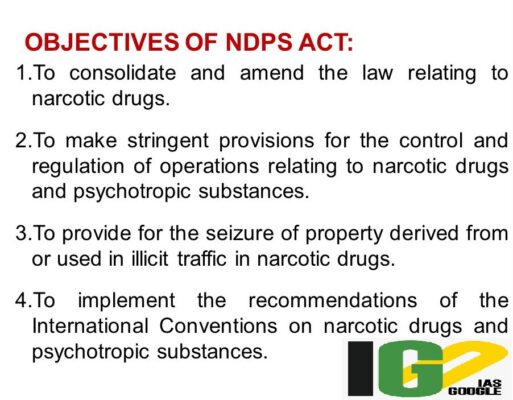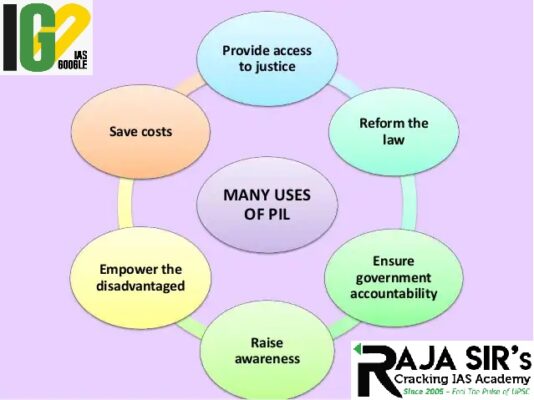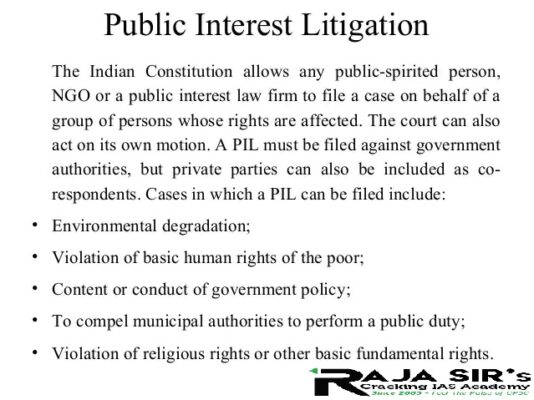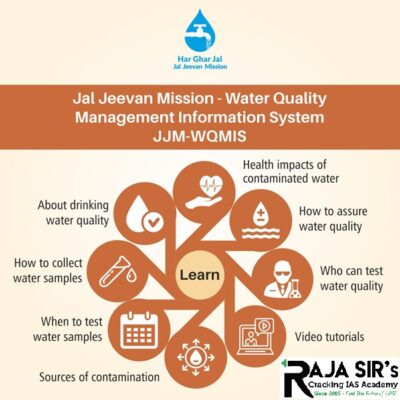- Home
- Prelims
- Mains
- Current Affairs
- Study Materials
- Test Series
05th Oct 2021
WHAT ARE THE SECTIONS OF NDPS ACT INVOKED AGAINST ARYAN KHAN IN DRUGS BUST CASE?
Eight persons, claimed a part of an alleged drug bust on a cruise ship recently are charged with various sections of the Narcotic Drugs and Psychotropic Substances (NDPS) Act.
NCB has invoked 4 sections of the NDPS Act so far. These include:







- Section 8(c): The section has wide provisions for producing, manufacturing, possessing, selling, purchasing, transporting, using, consuming, importing, exporting any narcotic drug or psychotropic substance, except for medical or scientific purposes, and requires a licence or permit by the concerned authorities.
- Section 20 (b): possession of cannabis is a punishable offence.
- There will be rigorous imprisonment for a term which may extend to ten years and will also be liable to a fine which may extend to Rs 1 lakh.
- Section 27: consumption of any narcotic drug or psychotropic substance is a punishable offence.
- Whoever consumes any narcotic drug or psychotropic substance shall be punishable with rigorous imprisonment for a term which may extend to one year, or with fine which may extend to Rs 20,000 or with both.
- Section 35: presumed that the accused knew what they were doing. Hence, the accused will be guilty unless proven innocent.
- Under this section, “culpable mental state” includes intention, motive, knowledge of a fact, or reason to believe a fact.
- Consumption of cocaine carries up to one year of imprisonment, whereas consumption of charas or cannabis carries up to 6 months
- The Narcotic Drugs and Psychotropic Substances Act, 1985, commonly referred to as the NDPS Act, is an Act of the Parliament of India that prohibits a person the production/manufacturing/cultivation, possession, sale, purchasing, transport, storage, and/or consumption of any narcotic drug or psychotropic substance.
- The bill was passed in the Parliament in September 1985, and came into force on 14 November 1985.
- The NDPS Act has since been amended four times — in 1989, 2001, 2014 and 2016.
- The Act extends to the whole of India and it applies also to all Indian citizens outside India and to all persons on ships and aircraft registered in India.
- The Act provides for lawmakers to expand the list of psychotropic substances or remove items from it on the basis.
- As per the Act, “narcotic drug” means coca leaf, cannabis (hemp), opium, popy straw and includes all manufactured drugs.
- Further, “psychotropic substance" refers to “any substance, natural or synthetic, or any natural material or any salt or preparation of such substance or material included in the list of psychotropic substances specified in the Schedule".
- The punishment is graded into three categories depending on the quantity of drugs seized and also provides for judicial discretion as far as the severity of punishment is concerned.
- Punishment for the cultivation of any cannabis plant may extend to rigorous imprisonment for up to 10 years and can also involve a fine which may extend to Rs 1 lakh.
- Punishment for the seizure of a “small quantity" of cannabis can involve rigorous imprisonment of up to one year and include a fine of up to Rs 10,000.
- When the seizure is of a “quantity lesser than commercial quantity but greater than small quantity", the convict can be awarded rigorous imprisonment of up to 10 years and be asked to pay a fine of up to Rs 1 lakh.
- The petitioner was seeking the implementation of the National Health Policy 2017 formulated by the Union government.

- PIL is the use of the law to advance human rights and equality, or raise issues of broad public concern.
- It helps to advance the cause of minority or disadvantaged groups or individuals.
- Public interest cases may arise from both public and private law matters.
- PIL is used to challenge the decisions of public authorities by judicial review.
- Judicial review is a form of court proceeding in which a judge reviews the lawfulness of a decision or a failure to act, by a public body.
- The concept of (PIL) is suited to the principles in Article 39A of the Constitution to protect and deliver prompt social justice with the help of law.
- After the emergency era, the high court devised a means for any person of the public approaching the court to seek legal remedy in cases where public interest is at stake.

- PIL was filed by G. Vasantha Pai who filed a case in the Madras High Court against the sitting Chief Justice of the Madras High court S. Ramachandra Iyer.
- It was found the judge had forged his date of birth to avoid compulsory retirement at the age of 60.
- in 1979, Kapila Hingorani filed a petition in regards to the condition of the prisoners detained in the Bihar jail.
- The petition was signed by prisoners of the Bihar jail and the case was filed in the Supreme Court of India as Hussainara Khatoon Vs State of Bihar.
- In the case of SP Gupta vs Union of India,1981 that the Supreme Court of India defined the term "public interest litigation" in the Indian context.
- It gives a wider description to the right to equality, life, and personality, guaranteed under part III of the Constitution of India.
- It is an effective instrument for changes in the society or social welfare.
- Any person can seek remedy on behalf of the oppressed class by introducing a PIL.
- PIL hold public bodies to account by ensuring that they make appropriate decisions, act fairly and within the remit of their powers.
- Helps to develop the law by giving judges the opportunity to interpret legislation.
- Give vulnerable people a voice by highlighting an issue and providing a platform for advocating for their rights.
- Raise awareness of important issues encouraging public debate and media coverage.
- Problem of Competing Rights
- PIL actions may give rise to the problem of competing rights.
- When a court orders the closure of a polluting industry, the interests of the workmen and their families who are deprived of their livelihood may not be considered by the court.
- Disadvantaged Groups
- PIL matters concerning the exploited and disadvantaged groups are pending for many years.
- Inordinate delays in the disposal of PIL cases, render leading judgments merely of academic value.
- Problem of Judicial Directions
- The courts are unwilling to punish the violators of their own orders through the exercise of their contempt power.
- Frequent, defiance of judicial order might dilute the credibility of the courts.
- The app would enable anyone to fund provision of tap water in rural parts of India.
- The Prime Minister also released a framework for water quality monitoring and surveillance as well as a ‘margdarshika’ (guide) for Gram Panchayats and paani samitis (village water and sanitation committees under the JJM).

- The JJM was launched in 2019 by the Union Ministry of Jal Shakti to ensure 100 per cent functional tap water supply in rural areas by 2024.
- The programme also implements source sustainability measures as mandatory elements, such as recharge and reuse through grey water management, water conservation, rain water harvesting.
- The Mission is based on a community approach to water and includes extensive Information, Education and communication as a key component of the mission.
- Every rural household has drinking water supply in adequate quantity of prescribed quality on regular and long-term basis at affordable service delivery charges leading to improvement in living standards of rural communities.
- To provide FHTC to every rural household.
- To prioritize provision of FHTCs in quality affected areas, villages in drought prone and desert areas, Sansad Adarsh Gram Yojana (SAGY) villages, etc.
- To provide functional tap connection to Schools, Anganwadi centres, GP buildings, Health centres, wellness centres and community buildings
- To monitor functionality of tap connections.

- To promote and ensure voluntary ownership among local community by way of contribution in cash, kind and/ or labour and voluntary labour (shramdaan)
- To assist in ensuring sustainability of water supply system, i.e. water source, water supply infrastructure, and funds for regular O&M
- To empower and develop human resource in the sector such that the demands of construction, plumbing, electrical, water quality management, water treatment, catchment protection, O&M, etc. are taken care of in short and long term
- To bring awareness on various aspects and significance of safe drinking water and involvement of stakeholders in manner that make water everyone's business
- The JJM is managed by paani samitis (village water and sanitation committees (VWSCs)) to plan, implement, manage, operate and maintain village water supply systems.
- These consist of 10-15 members, with at least 50 per cent women members and other members from self-help groups, accredited social and health workers, anganwadi teacher, etc.
- The committees prepare a one-time village action plan, merging all available village resources. The plan is approved in a Gram Sabha before implementation.
- Ensures functionality of existing water supply systems and water connections; water quality monitoring and testing as well as sustainable agriculture.
- Ensures conjunctive use of conserved water; drinking water source augmentation, drinking water supply system, grey water treatment and its reuse.
- The Indo-Gangetic Plain (including the Indus and Ganga basins) includes the states and Union territories of Jammu, Kashmir and Ladakh, Punjab, Uttar Pradesh and Bihar.
- The study calculated the extent of flood protection that countries would need to employ in terms of years.
- The Indo-Gangetic Plain needs to employ flood protectionfor the next 875-1,000 years.
- They estimated the global cost of employing adaptive flood measures — depending on local economic scenarios and cost adaptation measures — by quantifying the cost of residual flood damage (RFD).
- RFDrefers to unavoidable increases in flood damage even under an adaptation strategy based on feasible adaptation costs.
- Adaptation strategy implies infrastructural measures employed to mitigate the risks posed by floods.
- According to the study's estimate, RFD in South Asia is estimated to be around four million while adaptive costs around three million.
- But the benefits from the measures employed are over 50 million under the RCP8.5/SSP5 scenario.
- RFD is part of the total expected annual damage (EAD) outlay.
- It is calculated by subtracting past EAD (1970 - 2000) and future EAD estimates (set to 1,000 years).
- RFD (as part of the gross domestic product) remains high in eastern China, the northern parts of India, and the central regions of Africa.
- According to data from Central Water Commission, the total flood-related losses in India were estimated to be over Rs 37 lakh crore from 1953 to 2017.
- Indo-Gangetic Plain or North Indian Plain is an extensive north-central section of the Indian subcontinent.
- They run parallel to the Himalayas, from Jammu and Kashmir in the west to Assam in the east, and drain most northern and eastern India.
- The 0.70-million km2 fertile plain encompasses most of northern and eastern India, the eastern parts of Pakistan, virtually all of Bangladesh, and Nepal's southern plains.
- The region is named after the Indus and Ganges rivers. Major rivers in this region are the Ganges, Indus, and Brahmaputra. Their main tributaries are Yamuna, Chambal, Gomti, Ghaghara, Kosi, Sutlej Ravi, Beas, Chenab, Teesta, and Meghna.
- Taiwan accused China of seriously damaging the status quo of peace and stability in the Taiwan Strait with its string of larger incursions.
- The incursions cause tension between the two sides of the Taiwan Strait and has threatened regional security and order.
- The ADIZ includes a greater area that overlaps with part of China's own air defence identification zone including some of the mainland.
- Taiwan, officially known as the Republic of China (ROC), is an island separated from China by the Taiwan Strait.
- It has been governed independently of mainland China, officially the People’s Republic of China (PRC), since 1949.
- China asserts there is only one China and Taiwan is part of it.
- It views the PRC as the only legitimate government of China, and seeks Taiwan’s unification with the mainland.
- China claims, Taiwan is bound by the 1992 Consensus, which was reached between representatives of the Chinese Communist Party (CCP) and the Kuomintang (KMT) party.
- The two sides don’t agree on the content of this consensus.
- In 1979, the United States established formal diplomatic relations with the PRC. It severed its diplomatic ties and abrogated its mutual defense treaty with the ROC.
- The United States maintains an unofficial relationship with the island and continues to sell defense equipment to its military.
- China has employed a variety of coercive tactics short of armed conflict.
- It has increased the frequency and scale of patrols of PLA bombers, fighter jets, and surveillance aircraft over and around Taiwan.
- It has increasingly sailed its warships and aircraft carrier through the Taiwan Strait in shows of force.
- Cyberattacks from China target Taiwan’s government agencies.
- It suspended a cross-strait communication mechanism with the main Taiwan liaison office.
- It restricted tourism to Taiwan, and the number of mainland tourists visiting Taiwan has fallen.
- China has pressured global corporations, including airlines and hotel chains.

- The study classified quality of observable nights for different astronomical usages like photometry and spectroscopy.
- It analysed datasets for the Indian Astronomical Observatory (IAO) in Hanle & Merak (Ladakh), and Devasthal (Nainital).
- The Hanle site has around 270 clear nights in a year and is one of the emerging sites for infrared optical astronomy.
- This is because water vapour absorbs electromagnetic signals and reduces their strength.
- Paranal in Chile, is the best site in terms of clear skies with around 87% of clear nights in a year.
- Devasthal has a larger number of clear nights compared to the other sites in the sub-continent but are highly affected by monsoons.
- Night observations at IAO-Hanle from 2M-Himalayan Chandra Telescope (HCT) is possible without any interruption due to monsoons.
- The cloud cover fraction for Hanle, Merak, and Devasthal were 66-75%, 51-68%, 61-78%, and 61-75%, at various time resolutions using reanalysis data.
- The study found decreasing trends for the cloud cover fraction over the central region of Africa, the Eurasian continent, and the American continents.
- It found increasing trends in the maritime and land regions in the Sahara Desert, the Middle East, Indian sub-continent, the Tibetan Plateau, and the Southeast Asian islands.
- This was caused by global warming and associated water vapour changes in land-oceanic regions.
- The region is located to the north of the Great Himalayas which consists of Karakoram, Ladakh, Zaskar and Kailash Mountain ranges.
- It is also called the Tibet Himalayan Region as most of the part of these ranges lies in the Tibet.
- The Karakoram Range is known as the ‘backbone of high Asia’.
- It is situated in the northern most range of the Trans-Himalayan ranges.
- It forms India's frontiers with Afghanistan and China and acts as watershed between India and Turkestan.
- It extends eastwards for about 800 km. The average width is 120-140 km.
- It is abode to some of the greatest Glaciers of the world outside the Polar Regions.
- K2 is the second highest peak in the world and highest in the Indian Territory.
- It lies to the north of the Leh and merges with the Kailash range in Tibet.
- The important passes that lie in the region are- Khardung La, and Digar La.
- It runs parallel to the great Himalayan Range. The Nanga Parbat (8126 mt) is the highest point in the north-west.
- Ladakh range is in the north of the Zaskar range which runs parallel to it.
- It has an average elevation of the 5,800 mt. above sea level and 300 km long.
- The Rakaposhi-Haramosh ranges are extension of the Ladakh range to the northwest.
- It is a branch of Ladakh range situated in the western Tibet.
- Its average elevation is 5,500-6,000 mt above sea level and width is 30 km.
- Mount Kailash (6,714 mt) is the highest peak of this range.
- River Indus originates from the northern slope of the Kailash range.









 Latest News
Latest News
 General Studies
General Studies